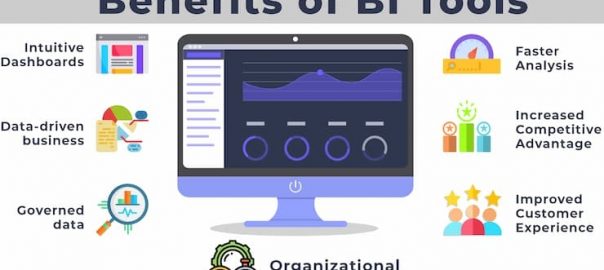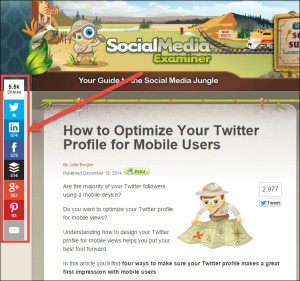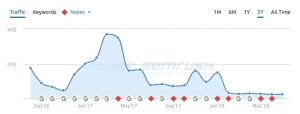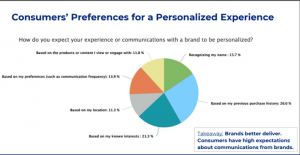One of the quickest and most efficient ways of improving the day-to-day running of your business is to use data to gain insights. Given the range of data that you can track through various tools, there are numerous ways in which a business can improve and ultimately, save money.
We’re going to look at the best business intelligence platforms that allow businesses to do just that. They work by offering insights and even predictions based on past performances, which are key to running a successful operation.
Throughout this article, we will review what are widely regarded as the best BI tools to see how they function, what they are best used for, how they compare to each other, and if they offer good value for money.
Our Pick for the Best Business Intelligence Platform for 2022
Microsoft Power BI takes our top spot as the best business intelligence platform. The brand is one of the most recognizable in the world and comes with features that include advanced analysis, huge data logs, a dedicated mobile app, data-driven insights, and stunning visuals.
Best Business Intelligence Platform – Top 10 List
The list below includes the best business intelligence platforms for 2022. What’s important to note here is that not all the platforms offer the same services and features, so take the time to see which is the best fit for your business.
It will be worth bookmarking this page as we continue to change and adapt this list based on ongoing testing and performance results.
- Microsoft Power BI – Overall best business intelligence platform
- Tableau Desktop – Best for large data sources
- Dundas BI – Best web-based business intelligence platform
- Sisense – Best for AI user reports
- Zoho Analytics – Best looking BI software
- SAP – Best for integrated reports for large-scale businesses
- TIBCO Spotfire – Some of the cheapest pricing packages
- MicroStrategy – Best for smaller or single-person businesses
- Looker – Great range of BI tools to implement strategies
- Amazon QuickSight – Massively reputable company and huge server space
Best BI Tools – Compared
We’ve taken the time to list the best BI tools to create a more in-depth look in terms of reviews. Our reviews have taken hours of work to produce and included an overview of what we think works and what doesn’t.
It’s worth noting that each of the picks are excellent business intelligence platforms and they each offer something a little different from the last. As we stated earlier, make sure you match up the features that you need from your BI tool with the features on offer within our review.
1) Microsoft Power BI – Overall Best Business Intelligence Platform
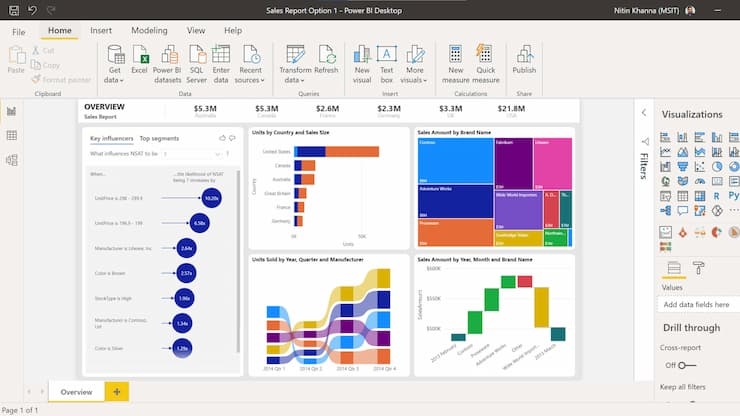
Microsoft Power BI is one of the most accessible BI tools on the market. One of the biggest pluses of this product is that it links with existing Microsoft products such as Word, Excel, and PowerPoint.
It comes in three convenient packages. Pro allows you to link to their cloud database for easy report sharing, Premium is designed to allow for the scale of medium-large businesses and Mobile allows you to get access via their app from anywhere in the world at any time.
One of the best things about Microsoft BI is that you get a downloadable platform that links with other predicts from the MS range. The layout and design is highly familiar to those already using Microsoft products.
The data-driven insights is where the platform really shines. It can prescribe quick measures that can be implemented, grouping, forecasting, and clustering, all as part of the analytics side of things.
Finally, the reporting visuals are some of the best that we’ve tested. You’re able to allow both teams and users to access reports and have huge scope when it comes to design. We would like to think that reports to people such as shareholders will benefit massively from this.
Pricing
Microsoft BI Pro starts from just $ 7.50 per month per user. With that, you get 1GB f data, an 8-day refresh rate, app access, and the ability to both publish and share reports. The Premium package jumps to $ 15.10 per user per month which increases usage to 100GB and a 48-day refresh rate. Corporate packages start from $ 3,800 per month.
Pros
- Free trial to get started
- Affordable making it accessible for smaller businesses
- Integration with existing Microsoft products
- Generally, easy to use
Cons
- The long learning curve to get the most from the software
- The support structure could be better
2) Tableau Desktop – Best for Large Data Sources
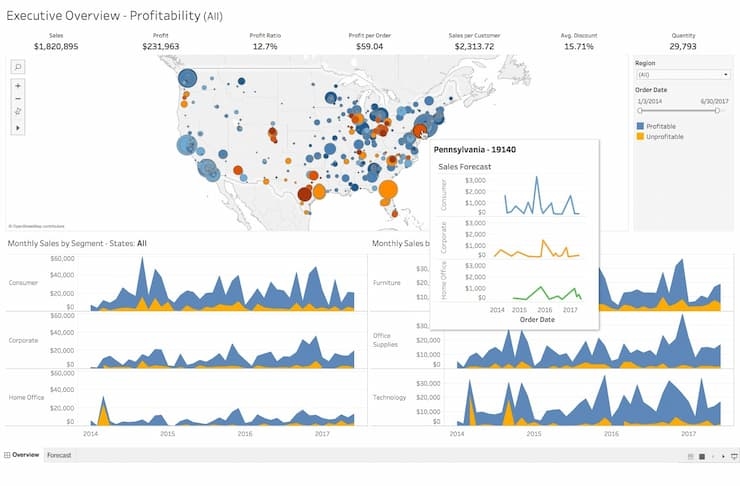
Founded in 2003 and used by companies such as Verizon, Charles Schwab, and Lufthansa, Tableau Desktop is one of the most powerful BI tools on the market. Its whole mantra is setup around giving companies the ability to process huge data sources and create stunning visuals on the back of this.
The platform allows for drag and drops functionally, which allows you to see and compare trends from different parts of the company or for eCommerce, different products. You can connect to a huge range of data sources, be it spreadsheets, data warehouses, or cloud data.
The analysis is one of the strongest tools with Tableau and it allows you to shape how that data is both processed and then presented. You can combine the data from multiple sources and use the visual assistant to suggest how best to produce visuals for those data sets.
Dashboards can be shared to both online platforms and a dedicated server. Access for each dashboard is accessible online and from tablet/mobile devices.
One of the things Tableau does better than most is have the capacity to handle huge amounts of data from multiple sources. Its ability to scale is almost unrivaled as well and comfortably handles business with thousands of employees.
Pricing
Pricing for an individual user starts from $ 70 per month per user. This gives you access to the full Tableau package. Teams and organizations also start from $ 70 per month per user, but you can add Explorer ($ 42) and Viewer ($ 15) for users which come with limited access to features. The latter is great for shareholders who just need to view data, rather than process it.
Pros
- Free trial available for the full Tableau package
- Great drag and drop interface
- Easy to use once you get up and running
- Ability to pull in huge amounts of data from multiple sources
- Easy to switch between visuals such as graphs and charts
Cons
- Can be very expensive for both small and larger businesses
- The steep learning curve for new users
3) Dundas BI – Best Web-Based Business Intelligence Platform
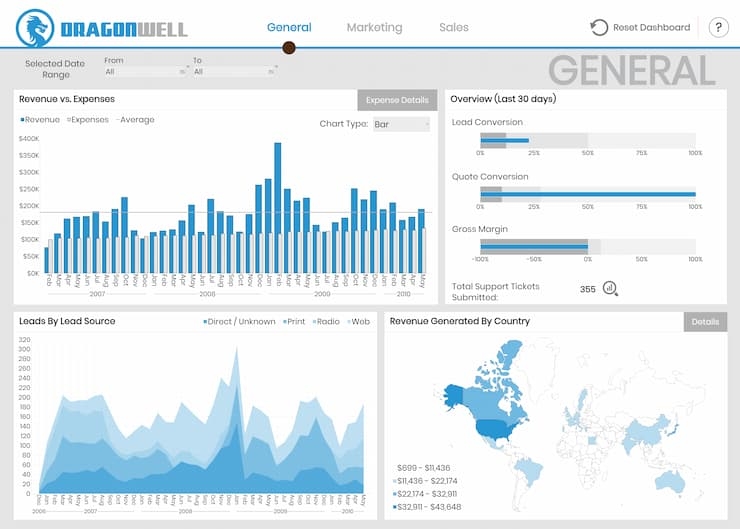
Dundas BI has been running for almost 30 years now and it’s the first on our list to be solely browser-based. The HMTL 5 platform that Dundas has been created allows for easy access both online and on mobile devices, removing the need for multiple applications.
Working as a single platform, Dundas BI removes the need for multiple tools to drag data across servers. This makes it one of the easiest bits of kit that we’ve tested and as a result, creates an extremally shallow learning curve.
Being able to compare data from different data sources and create an analytics platform that beings all together is one of the strongest selling points for Dundas. You can save a huge amount of time by having both intelligence and reporting in the same place and this is where it excels.
The addition of access to the Dundas support group means that you can utilize their expertise to help break down your data and create reports that are actionable. This comes at an additional cost but is great for smaller corporations who potentially don’t have a huge team around to break down what the numbers mean.
Pricing
Dundas comes with a free trial that we highly recommend you use. Frustratingly, pricing is only on a quote basis, meaning that there is no set rule for how much the program costs. However, base packages start from just $ 9.99, with customizable dashboards from just $ 30 (per user, per month).
Pros
- Real-time dashboard refresh rates
- Affordable licensing packages, are ideal for smaller businesses
- Links to expert help to breakdown your companies’ data
- HTML 5 platform means that no downloadable program is needed
- Out of the box, ready to go
Cons
- Steep learning curve (lots of information online, however)
- Content management needs to be improved
4) Sisense – Best for AI User Reports
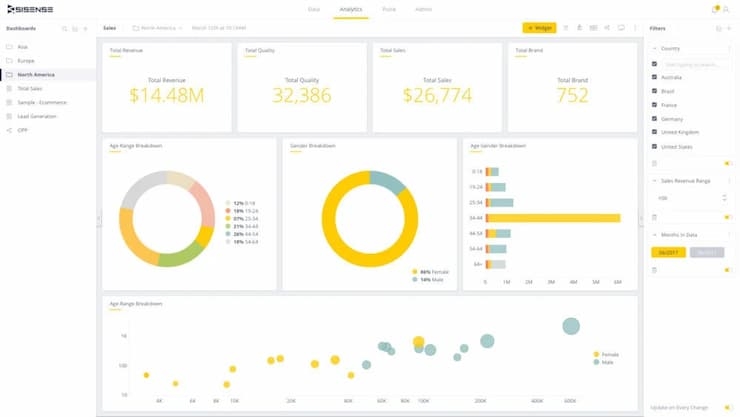
Sisense has been online since 2004 and is used by businesses that include Philips, Nasdaq, Outreach, and Outreach. The platform can connect to a wide range of data sources, including cloud-data servers, which pull in data constantly. It’s possible to choose how much and when the data is pulled into the program, which is a nice touch for larger businesses.
The platform works with a lot of AI-driven data. What this does is take the data that you’ve uploaded and then automatically create reports, analytics, and actionable processes to improve.
It works for a range of services, including HR, marketing, IT professionals, and finance. In fact, one of the best features of Sisense is that you can combine all the data from these sectors of your business, and it goes on to highlight how they better be linked.
Security is another huge positive for Sisense and they not only include product security, but also attack surface monitoring, global resiliency, third-party security, and people security. They are SOC2 Type II certified.
Pricing
Pricing is only available when you use the contact form on the site. Packages can start as low as $ 20 per user per month but given that it’s an incredibly customizable business. Intelligence platform, it’s impossible for us to say if this offers good value or not. They do offer a free trial, which we highly recommend that you take up.
Pros
- The AI-drive platform is great for getting processes based on data
- One of the easiest BI tools to use
- Shallow learning curve with lots of tutorials on their website
- Highly customizable based on the size of your business
Cons
- Response time from support is poor
- Expensive for smaller businesses
5) Zoho Analytics – Best Looking BI Software

Zoho Analytics is widely regarded as one of the best business intelligence platforms on the market right now. It works closely with a multitude of data integration processes, which include Excel, CSV JSON, XML, Dropbox, Google Drive, and even web URL.
The platform comes as a relatively straightforward drag and drops interface. It’s not the best that we’ve tested, but it’s easy to use and includes features such as auto model, smart cleanse, catalog data and enrich data. This then leads into the visual analysis section where you get a wide range of charts, widgets, and table views to choose from.
Augmented analytics is where Zoho excels and this inclusion of business insights and what-if analytics is a must-use feature. This allows you to see areas of the business that might be struggling based on the numbers and also potential pitfalls that may lie ahead.
Accessibility via online and its app means that you can check numbers on the go. It also allows for data to automatically be pulled from the source, keeping these channels up to date.
Pricing
The basic package starts from just $ 19 per month and with this, you get to include 2 users. This is ideal for small businesses. The more users you add, the more it costs, but even at its higher “Enterprise” package for 50 users, a price of $ 369/month is still very good value. If you need bigger than this then you move from its cloud package to an on-premises package, which starts from $ 24/month per user.
Pros
- Includes support from a wide range of data sources
- One of the best-looking dashboards in terms of design and ease of use
- Cheap packages are ideal for smaller business
- Easy scalability moving from cloud to on-premises packages
Cons
- Can be slow to load on larger databases
What is Business Intelligence Software?
Business intelligence software are applications that are designed to compile huge sources of data to then prepare for analysis. Data can be taken from a wide range of sources, such as external systems, cloud databases, customer databases, and internal programs.
Once the data has been processed, the software is then able to compare and plot the data to provide actionable processes that the company can undertake to improve. Improvement comes in a range of forms, but typically you will see things like an increase in productivity and ultimately, an increase in profit margins.
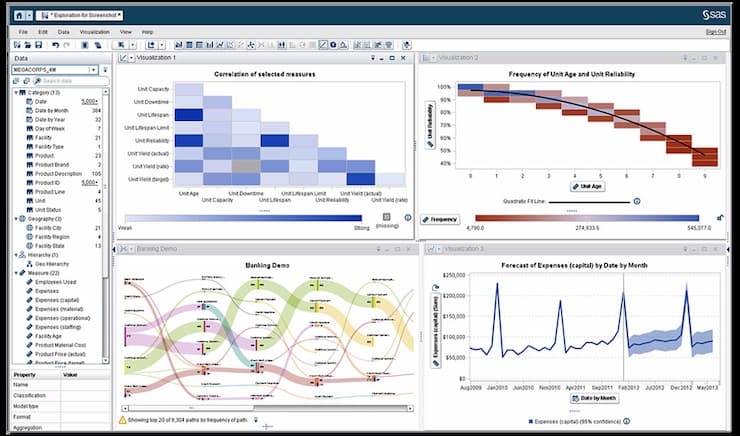
This data can be used to aid both employees and management. Most BI platforms are able to create visual aids, such as graphs and charts, which makes it easier to highlight what needs improving or changing.
Efficiency and KPI’s are two key areas that business intelligence software helps to improve a business. The class quote “time is money” is very applicable here, with BI software helping to save both.
How Does Business Intelligence Software Work?
Business intelligence software all starts with goals and queries that a business might have. These are usually based on the performance of how well the business is running and then change to how the information that they have stored from the business can help them reach their goals.
Data is collected from a range of areas of the business and then stored in a data warehouse. This might be on internal servers or more commonly in today’s market, on the cloud.
The company then uploads the data to their BI software. If this is an ongoing process then this might already be automated, but if a company is using BI software for the first time, then this may take a reasonable amount of time if data stores are high.
Once the upload of data has been completed, the business intelligence software then starts to process and analyze. More of than not, the software simplifies how this looks using visual aids, such as graphs and graphics. It’s generally considered to be easier to spot areas of interest by doing it like this.
The next stage is that the company needs to process what the data and analysis means. The best BI software will give the company indications as to what needs to be improved based on the current data, however, this is often limited, and manual oversight is always encouraged.
Most companies will then need to ask questions about why the data shows what it does and then how they can change or improve on this. It’s an integral part of both expansion and efficiency for all businesses.
How Can Business Intelligence Software Help Managers?
The best business intelligence software will allow managers to quickly and easily see where any issues lie within the company that they can act on. It’s not necessarily going to be a linear process here and more something that will need monitoring, but it’s a lot easier to spot changes and issues that may of detriment to the business.
However, one of the strongest tools that help managers is the ability to ask questions. We’ve mentioned this previously, but it lets them understand better what sections of the business are working and why any issues might be appearing.
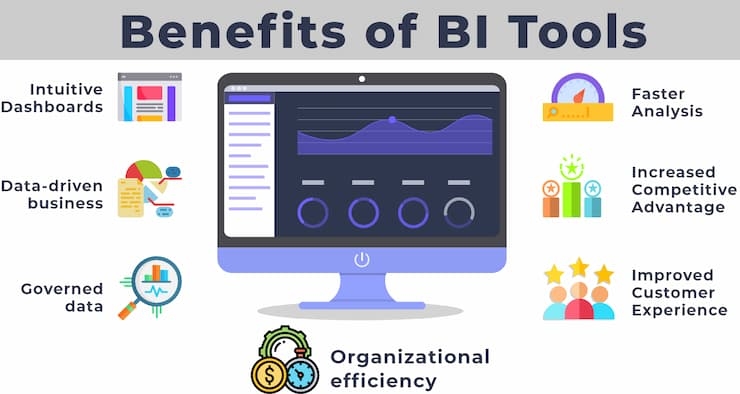
For example, let’s assume that a manager has 4 sites that are running in different states throughout the US. Profits have been up year on year for the last 5 years. From the outside, this would be a successful business that is continuing to improve.
Let’s assume that only 3 of the 4 sites are making a profit and 1 is making a loss. The manager could use all the data from the three profitable sites to see how it differs and compare them to the site that is losing money.
This allows him to ask questions about what is being done differently and how it can be acted on. It could be something such as a difference in pricing for the same product or that staff wages are higher in that store.
Without a business intelligence platform in place, the manager would be guessing as to what the issue is. With the best business intelligence platform working, it makes it much easier to compare where the store losing money is weaker.
How to Choose a Business Intelligence Tool or BI Tool?
We’ve outlined some areas of interest to pick the best business intelligence tool. With each, we’ve stated how it works and which tools excel in these areas.
Dashboarding and Visualization
Dashboarding and visualization are how the BI tool can show the data within things like graphs and charts. There are two standouts for this which are Tableau and Dundas. The latter gets the nod based on the fact it’s the only browser-based BI tool and Tableau is just generally one of the best-looking periods.
Security
All the Business intelligence platforms on this page offer the highest security. However, the standout was that of Sisense who were SOC2 Type II certified, offering the highest possible levels of security for your data.
Advanced Analytics
Microsoft Power BI takes the top spot when it comes to advanced analytics. They allow you to get a huge range of data points and create several comparison graphs and tables. What’s most impressive is that they link these data points across various sections of the company including marketing, finance, and HR to see if there are any broken links.
Mobile BI
Again, Microsoft Power BI takes up the top spot here with a dedicated mobile app that can be downloaded across the company. This can be a huge asset for managers, employees and shareholders to access and allows admins to only release the data or analysis that they see fit for each account.
Conclusion – What is the Best Business Intelligence Software?
Microsoft Power BI has taken the top spot as the best business intelligence software. The platform comes from one of the most recognizable brands in the world and this means that it links with a wide range of products that most businesses will have integrated into their systems.
Its ability to offer a pricing structure that starts from just $ 7.50 per month per user makes it highly accessible to small businesses, as well as having the capacity to scale for those with thousands of employees. Advanced analytics, a dedicated mobile app, stunning visuals, and data driven problem solving all add to what is the best package on the market right now.
FAQs
What business intelligence software is best?
Microsoft Power BI is ranked as our number one business intelligence software. It comes at a competitive price point for small businesses whilst having the ability to scale.
How much does a BI tool cost?
Prices can start from as little as $ 7.50 per month per user. Most platforms will then charge per user per month, but some will be capped for corporate packages which potentially thousands will be able to access.
Can I get a free business intelligence tool?
Yes, most BI tools will have some sort of free trial to get started. All of the best business intelligence software will require a paid subscription to continue to use that product.
(124)
